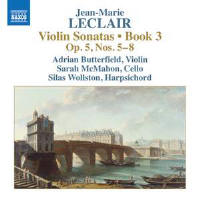Texte paru dans: / Appeared in: |
|
|
Outil de traduction |
|
|
It’s strange that there aren’t more recordings of Leclair’s Op 5 Violin Sonatas, given how much they have going for them. Dedicated to King Louis XV and published in 1734 (the brief grace period between Leclair’s 1733 Versailles appointment as Director of the Music of the Chapel and the Apartments, and his 1736 resignation due to a dispute with another violinist), its 12 sonatas are a tale of folky drones – presumably hitting the king’s personal taste buds – meeting courtly grace and dance forms, with a stylistic span ranging from the sombre dignity of No 6’s opening Grave through to the suddenly concertoesque No 8. So we can be grateful to Adrian Butterfield for taking it upon himself to work his way through the book, and this second instalment, containing Nos 5-8, is a strong successor to the first four (3/22).
As before, Butterfield makes stylish work of capturing Leclair’s famed taste, neatness, sweetness and dance feel. Equally as before, he’s matched at every step by cellist Sarah McMahon and harpsichordist Silas Wollston. I’ve also found myself enjoying both the twists of peasanty grit he brings to proceedings – whether over simple inflections or to colour embellishments – and the thought with which they’ve been applied. For instance, the busily leaping melodic line of No 5 in B minor’s first movement retains a thoroughly courtly elegance; but come the final variation movement, you immediately sense a more bucolic feistiness to Butterfield’s articulation, not to mention a building excitement as things tip into Prestissimo territory, and all with a neat dexterity and range of colouristic detail to the shaping that suggests that for Butterfield it’s all as effortless as falling off a log. McMahon meanwhile dances alongside him, just a tad further back in the balance, with corresponding airy pounce.
On to No 6 and the Grave’s technically hairy succession of double-stopped chords, tight broken arpeggios and sprinkled embellishments, where Butterfield brings a satisfying combination of rich-toned legato expansiveness and filigree delicacy. No 7’s slow movement meanwhile strikes both for the way McMahon rises up to duet with Butterfield (now more equal in the balance) and for Butterfield’s own colourfully vibrato’d cantabile. Add No 8’s outer movements of concerto-like exuberance – again including some great dialogue between Butterfield and McMahon over their ascendingscale flourishes in the final Allegro – and there’s much to enjoy here. |
|
_small.jpg)



